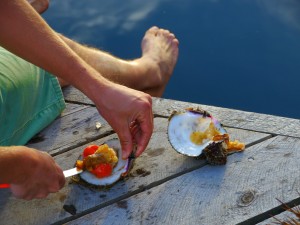
We have all sorts of questions when we travel abroad because so many things are new and different. When I first started traveling, many of my questions were about food. I wondered whether I would like what was on offer, whether I’d make any embarrassing mistakes in a restaurant, and whether I’d get sick.
With so many international restaurants close to home, it’s now easy to sample traditional cuisine before a trip to become comfortable with the names and flavors of dishes. The more I travel the more I learn about manners around the world, and I’ve shared several tips in International Dining Etiquette. So, can I reassure you about food safety, too?
Fresh fish from the sea. Photo by Johanna Read, Traveleater.net
First, full disclosure: I’m not a food scientist or a doctor. But I was an executive in two Canadian government departments that dealt with food safety issues. While I pay attention to the official safety guidelines, I pay more attention to what the food scientists themselves do and don’t do. Armed with this information, I’ve changed many of my own eating habits.
Note that my advice is for the average person. At-risk populations, such as people with allergies or weakened immune systems, pregnant women, adults over age 60, and children under six, need to take more precautions.
The Dreaded Traveler’s Diarrhea
Many people get a little tummy trouble when traveling, and they’re often quick to blame it on substandard sanitary conditions in the country they’re visiting. They’re not always right.
Sometimes, intestinal distress is just because we’ve adjusted our diet—more booze, more junk food, less water, and different fiber—than our systems are accustomed to. We’re also more prone to “the trots” when traveling because our bodies have resistance to many of the minor food- and water-borne bacteria, parasites, and viruses we have at home, but not to the novel ones we encounter abroad. This is usually why local residents can drink tap water but tourists may be advised to use bottled.

Travelers are often cautioned to “boil it, peel it, or leave it,” but I think this is too extreme for most places we travel. If I’d followed this rule, I would have had to go almost veggie-free for months at a time, never discovered that Turkey has the finest cherries in the world, and missed out on Laos’ incredible soups topped with mountains of fresh herbs.
My bouts of Montezuma’s revenge have (knock on wood) been very minimal. Here are my tips to help you keep it at a minimum too.
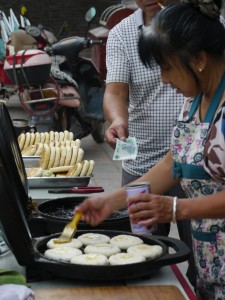
Wash Your Hands
The biggest food safety mistake is not washing your hands enough. If you’ve touched money or a handrail, opened a door, scratched your nose, or brushed dust off your pants after sitting on a park bench, your hands are filthy. Ready to enter your body could be benign dirt, viruses that cause colds or flus, serious food safety culprits such as E.Coli or Giardia, or the norovirus, which causes diarrhea and vomiting gastroenteritis (what many people incorrectly call “stomach flu”).
Wash your hands between touching money and eating food. Photo by Johanna Read, TravelEater.net
Develop new habits to avoid touching things, including your face. Hit elevator buttons with your elbow. Use paper towel on the bathroom door knob when you leave public washrooms. Wash your hands often in warm water and soap before you eat. Yes, a hand sanitizer or wipe is good, too, but please be discreet when using them so you don’t leave the impression that you think the country you’re in is dirty. It is, but it’s no dirtier than the country you’re from.
Beware the Buffet
One of the biggest mistake travelers make is assuming the hotel buffet is safe and the street food cart is not.
Most (but not all) buffets do a reasonably good job at switching out plates of food regularly and keeping cold foods cool and hot foods at least warm. Foods not kept at their proper temperature are perfect for growing bacteria, so it’s worth it to pay attention. I won’t eat food that looks like it’s been sitting too long. If the buffet has a cook-to-order section I always get my food there.
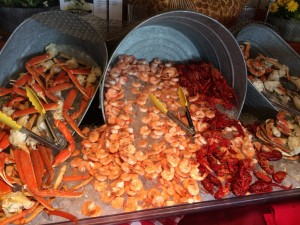
The main problem at a buffet is your fellow diners. Next time you’re eating at one, look at where they’ve left the serving utensils. I’ll bet you anything at least half of the handles are touching the food. These handles are not clean at all—they’re been touched by dozens of hands. And those hands have been touching chairs, salt shakers, drippy bottles of sauce, dirty napkins, and perhaps have even been put inside a mouth to fish out a piece of bone or gristle. Shudder.
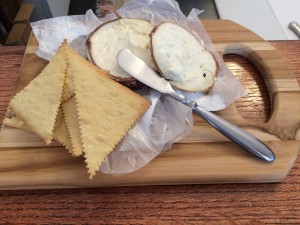
I’ve also learned not to reuse my glass or plate when I go up for seconds. Picture this: thinking I’m being environmentally-conscious, I take my slightly dirty plate back up to the buffet for seconds of that fabulous thick curry. When I’m serving myself, I touch my plate with the serving spoon and then put the spoon back into the warm dish. But my plate has had my saliva-covered fork touch it countless times, and I’ve just transferred a minute portion of that saliva into the serving dish. Let’s just hope that you’re already immune to my germs or that the restaurant replaces the dish and serving spoon before you approach the steam table.
A good buffet will have hand-sanitizing stations near the entrance and at the food stations, small plates to hold serving spoons, frequently replaced food and utensils, and on-the-ball servers who take your plate away quickly so you’re forced to use a new plate when you go back for seconds. And, most importantly, diners who look out for everyone’s food safety.
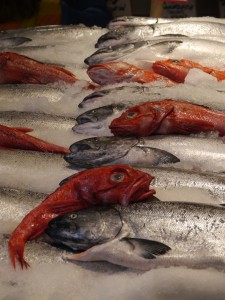
Street Food is Often Safer
I prefer street food over buffets. First, I’m trying something more authentic to the place I’m visiting (e.g. the Ugandan Rolex—yum!). Safety-wise, the vendor is cooking in smaller batches, I can watch his or her food handling practices, and I know exactly how long my meal has been cooling off before I eat it. I check on how meats are stored (on ice or in a fridge?) and look to see where the plates and cutlery have come from. If they’re just rinsed in a plastic container behind the food cart, I choose somewhere else. Disposable plates and forks aren’t environmental, but they are cleaner.
Generally if there’s a line of local residents, especially parents with kids and their sensitive bellies, I’m pretty confident the vendor has safe food.
I do avoid the buffet-type street food stalls. Though I can see the kind-looking mothers and grannies who’ve spent the day preparing the wide variety of local dishes, I have no idea how long those dishes have been sitting outside potentially growing bacteria. And I don’t trust the cleanliness of the hands of my fellow travelers any more on the street than at the buffet restaurant.
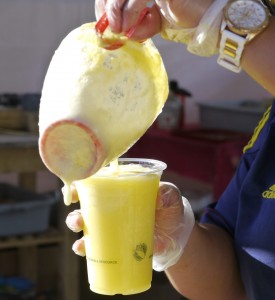
What is that Person Doing?
I’m very aware of other people’s hands. I prefer when the person preparing my food is not wearing plastic gloves. When we wear gloves we can’t feel how dirty our hands are, and so we wash them less frequently. We still scratch that itch and grab stuff—none of it sterile—and then go right back to touching the food we’re preparing, wrongly assuming the plastic is as clean as our skin still is. I also make sure the person handling money doesn’t prepare my food before washing their hands.
Social norms in the country I’m visiting also affect how much attention I pay to food safety. Have citizens adopted the cough-and-sneeze-into-your-elbow-not-your-hand routine? In some places public nose-picking seems not to be a faux pas (ugh!). Is there warm water, soap, and a mechanism to dry hands in washrooms? Depending on these local norms, I wash my hands much more often and try extra hard to avoid touching things in public.
Some countries have unique problems. For some reason beyond my comprehension, every person save one in Thailand grabbed a straw at precisely where my lips were meant to go before putting it into my freshly made smoothie or iced coffee. Mrs Pa, who makes the best smoothies in the world, was the only exception—find her orange cart opposite the South Gate in Chiang Mai.
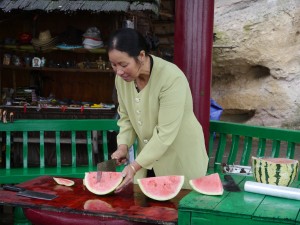
Choose Foods Carefully
Some foods are, by nature, less safe than others. I avoid pastry-wrapped foods such as meat pies, samosas, and curry puffs. It’s difficult to keep the insides hot or to cool them properly. They’re usually just warm enough to provide the perfect growing conditions for bacteria.
I do eat salads and most raw fruits and veggies abroad—in fact, sampling the unusual fruits in the country I’m visiting is one of my favorite aspects of traveling. However, there are a few I avoid wherever I am in the world, even at home in Canada. I don’t eat raw sprouts or unpeeled cucumbers. The curly structure of the sprouts and the tiny holes in cucumber skin means it’s impossible to wash all the E.coli and other disease-causing microbes out of them.
I’m happy to order rare steak, but I’ll eat rare hamburger only in top restaurants where I’d also trust their steak tartare. I’ll gorge myself on raw-milk cheese, but won’t eat dairy that’s sold on the beach unless it’s in ice cream form. I like my Eggs Benedict runny. I’ll eat ceviche every night, but only freshly-made, not the Panamanian kind stored in jars (even though Anthony Bourdain survived it just fine). Under instructions of my travel medicine doctor, I avoid Turkish watermelon. Supposedly they’re injected with water to make them heavier and therefore able to be sold at a higher price.
And those fabulous Turkish cherries? After I bought them at the market I rinsed them, twice, with bottled water. And I went back every day for more until I had to fly home.

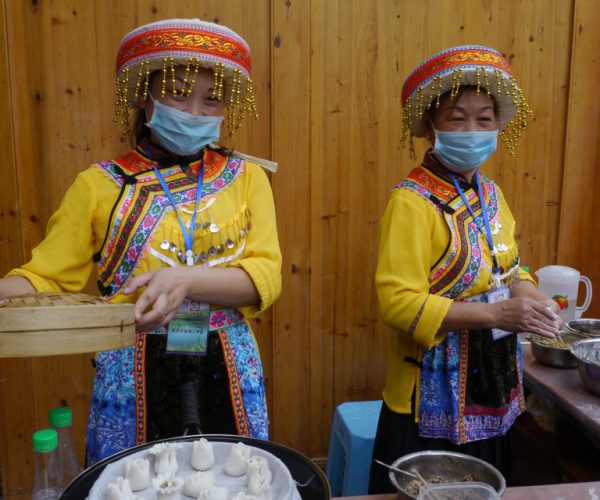
Leave a Reply